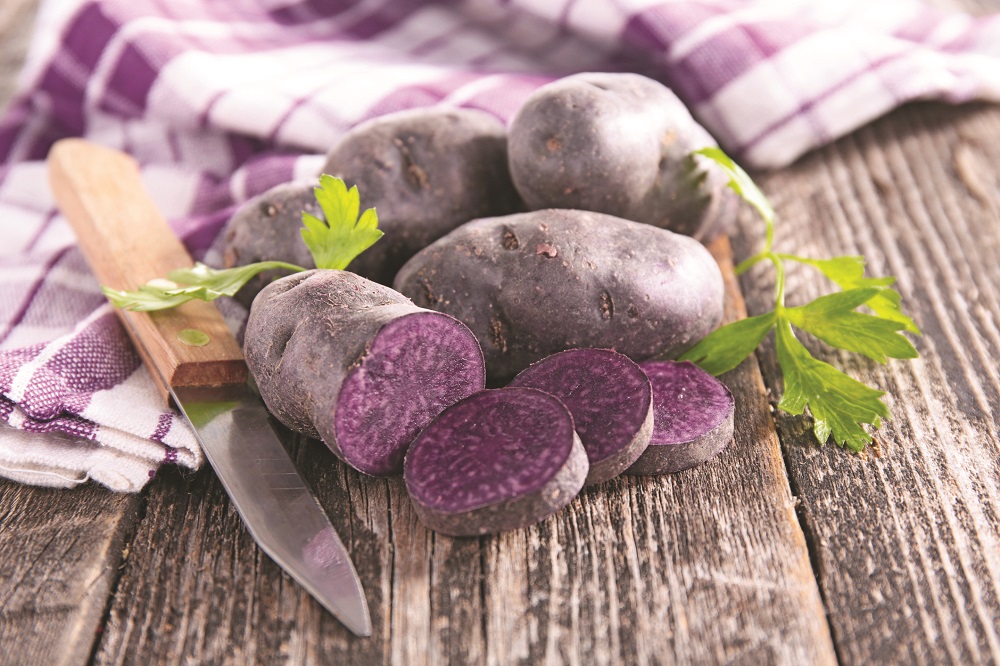Black beans or cannellini? Purple potatoes or white? Black rice or brown? When you have the choice, always go for the darker plant food option. Why? Because most dark plant foods contain a magical health-promoting chemical pigment called anthocyanin. Fruits, vegetables, and grains with red, purple, blue, or black hues tend to be rich in anthocyanins. Anthocyanins are powerful antioxidants that can help your body prevent a host of diseases, such as diabetes, certain cancers, obesity, and cardiovascular diseases. They also possess anti-inflammatory and antimicrobial effects. In addition, studies show that diets high in anthocyanins can boost your brainpower and your mood.
Eggplant is rich in an anthocyanin called nasunin. Nasunin is mainly confined to the peel of eggplant, and it represents between 70 and 90 percent of the total anthocyanins in the peel. Try my delicious, and super nutritious, anthocyanin-rich eggplant dish below and turn to page 16 for more high-anthocyanin foods.
Purple potatoes: Try the trendy purple potatoes with purple skin and flesh. Besides anthocyanins, they have two to three times the total antioxidants of a typical white potato. All potatoes are loaded with potassium, magnesium, vitamin C, and fiber, so add in the anthocyanins for a true superfood effect.
Purple cauliflower: Purple cauliflower has the benefit of not only being an anti-cancer cruciferous vegetable, but the dark hue is a visual indicator that this food also contains a nice amount of disease-fighting anthocyanins. Steam, stir-fry, or microwave your cauliflower, or eat it raw, to preserve the most nutrients.
Black mission figs: Fresh figs are a healthy treat that’s divinely sweet; plus they offer a healthy dose of anthocyanins as well as fiber and bone-boosting minerals. And all this nutrition for a mere 37 calories in a single whole fresh fig.
Blueberries: Blueberries are bursting with nutrition and are also great sources of anthocyanins. Blueberries are a true “superfood.” They are sweet, nutritious, and wildly popular. A one-cup serving contains a quarter of the recommended daily value for vitamin C and 4 grams of dietary fiber, but only 80 calories.
Dr. Janet’s Eggplant Stacks
Ingredients:
- 1 medium eggplant, sliced
- 1⁄8 cup extra-virgin olive oil
- 1 large steak tomato, sliced
- 1 cup of goat cheese, crumbled
Balsamic Caramelized Onions:
- 2 yellow onions, thinly sliced
- 1⁄4 cup extra virgin olive oil
- 1⁄4 cup brown sugar
- 1 cup balsamic vinegar, divided
Directions:
- Preheat oven to 350°F.
- On a baking sheet, place the sliced eggplant. Pour 1⁄8 cup of olive oil in a small bowl and brush both sides of the eggplant slices with oil.
- Roast the eggplant slices for 45 minutes (flip slices over every 15 minutes).
- While the eggplant is roasting, make the onions (see Tip). In a medium skillet over medium heat, warm the olive oil. Add the onions and cook, stirring often, until starting to soften (about 10 minutes).
- Add the brown sugar and 2⁄3 cup of the balsamic vinegar to the skillet and stir. Reduce heat to medium-low and continue to cook, stirring often, until deep golden and a jam-like consistency, 45 to 60 minutes.
- Deglaze the pan: Remove the onions from the pan and pour 1⁄4 cup of balsamic vinegar into the pan. As the liquid bubbles, scrape up the bits and reserve the glaze to pour over stacks.
- Create your stack: Layer one eggplant slice, one tomato slice, 1⁄8 cup of onions, one slice of eggplant, 1⁄8 cup of onions, a sprinkle of goat cheese, and 2 tablespoons of balsamic glaze (bottom to top).
Nutrition per serving (per stack): Calories 237; Total fat: 12g; Saturated fat: 2g; Cholesterol: 7mg; Sodium: 66mg; Carbohydrates: 28g; Fiber: 6g; Sugar: 2g; Protein: 5g.
Tip: You can’t rush true caramelized onions. Making them at home is simple but requires patience. The sugars trapped inside the onion layers caramelize steadily with time and a medium-low heat.


